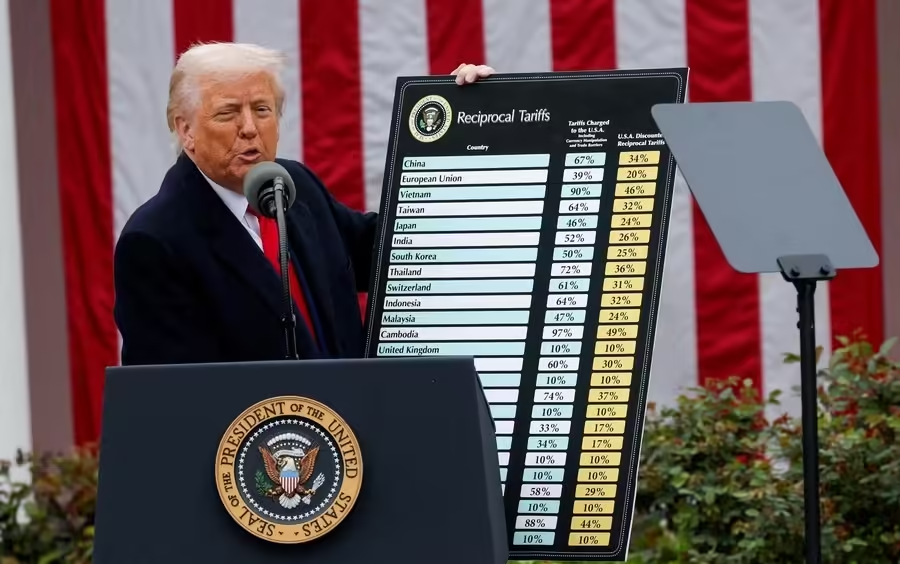Trump’s 104% tariffs spark market chaos, global recession fears, and worldwide trade tensions.
The global economy is bracing for impact as U.S. President Donald Trump’s sweeping new tariffs on dozens of nations officially come into force. With some Chinese imports now slapped with duties as high as 104%, and long-time allies like the EU also facing steep trade penalties, financial markets have entered a tailspin. Investors are scrambling to reassess global risk, while central banks and policymakers from Asia to Europe prepare for economic fallout. Trump’s bold declaration of “reciprocal” trade measures has already wiped trillions off the markets and rattled global alliances—marking a turning point in modern trade policy and global economic stability.
Trump’s Tariff Avalanche Hits Full Force
At 12:01 a.m. ET on Wednesday, President Donald Trump’s long-threatened tariff escalation became reality, as a new wave of reciprocal tariffs took effect. Leading the list: a staggering 104% tariff on Chinese imports—nearly doubling last week’s 54% rate—as part of Trump’s broader effort to “correct America’s trade imbalances.” These tariffs are not limited to adversarial nations; close allies like Japan, South Korea, and the EU have also been targeted with punitive trade measures.
According to Trump, these steps are aimed at countries “ripping off the U.S.,” including allegations of currency manipulation and unfair barriers to American goods. Speaking at a White House event, he insisted the tariffs are “permanent,” even as he hinted at possible future negotiations with affected countries.
Also Read: US-China Trade War Escalates: Tariffs Hit 245% Amid Rising Global Tensions
Global Fallout: Allies and Rivals Scramble
China, the most heavily targeted nation, vowed to retaliate. Its Ministry of Foreign Affairs condemned the U.S. actions as economic bullying, with officials pledging not to accept the “abuse of tariffs” without a response. Beijing’s central bank is intervening to stabilize the yuan, instructing major state-owned banks to limit U.S. dollar purchases to prevent excessive currency depreciation.
Taiwan, another affected region, introduced a five-day short-selling restriction to curb market volatility, while Vietnam—one of the nations hit hardest by the new tariffs—is seeking urgent talks with U.S. Treasury officials.
On the diplomatic front, Washington has scheduled trade talks with South Korea and Japan, while Italian Prime Minister Giorgia Meloni prepares for a visit. The European Union, hit with a flat 20% tariff along with industry-specific duties, is voting on counter-measures. German officials have warned that a recession is now a clear possibility for Europe’s largest economy.

Markets React: Global Selloff, Recession Fears Rise
Financial markets responded with panic. The S&P 500 suffered its steepest decline since its inception in the 1950s, pushing it dangerously close to bear market territory. European stocks dropped in tandem, and Asian markets—except for China, which received state-backed support—sank amid the uncertainty.
Alarmingly, global benchmark bonds also experienced selloffs, signaling forced liquidation and a flight to cash. This downturn in typically safe assets has raised red flags among investors, suggesting deeper systemic risks are brewing. Oil prices plunged for a third consecutive day, with Saudi Arabia slashing its flagship crude price by the largest margin in over two years.
Meanwhile, traders are now betting that the U.S. Federal Reserve may be forced into an emergency interest rate cut, even before its next scheduled meeting.
U.S. Consumers and Businesses Brace for Impact
While Trump has doubled down on his tariffs, touting them as leverage to force fairer trade deals, economists warn of long-term domestic consequences. Many U.S. consumers will bear the brunt of higher prices on everyday items—from electronics and clothing to food and home goods.
A recent Reuters/Ipsos poll reveals that nearly 75% of Americans expect price hikes over the next six months. Danish audio brand Bang & Olufsen has already announced price increases on select products to offset the cost of tariffs, and other businesses are expected to follow suit.
The full impact may not be immediately visible, as goods already en route to the U.S. before the tariff deadline are temporarily exempt if they arrive by May 27.

More Tariffs on the Horizon?
If Trump’s comments to Republican lawmakers are any indication, the U.S. tariff offensive is far from over. He teased “major” upcoming duties on pharmaceutical imports—one of the few categories previously spared from penalties. This would widen the scope of the trade war further, affecting healthcare supply chains and increasing the pressure on foreign governments to strike deals.
Trump’s tough stance continues to blur the lines between trade policy and geopolitical strategy, raising the stakes for multilateral economic cooperation. His administration argues that these moves are necessary for America’s long-term economic security and to curb foreign manipulation. Critics, however, warn that escalating tariffs risk throwing the global economy into a prolonged recession.





